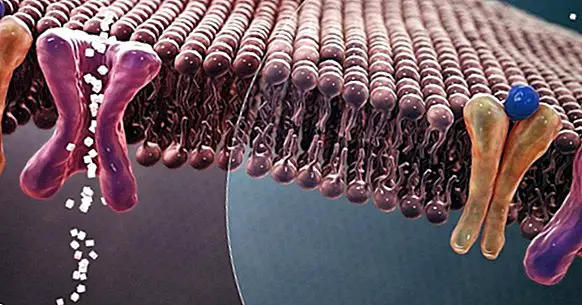Diabetic neuropathies: types, symptoms, causes and treatments
The sugar. A substance that hides practically in any food and that, with time, has been increased its consumption until reaching levels of great concern. This concern is based on the large number of health effects that this sweet and addictive substance has.
One of these consequences is diabetes. Which, although it does not have to be highly damaging to the person, can get complicated. That's when the so-called diabetic neuropathies appear , of which we will talk throughout this article.
- Related article: "The 15 most frequent neurological disorders"
what is the diabetic neuropathy?
Diabetes is a type of condition that is characterized by producing, in those who suffer from it, high blood sugar levels. This excess of glucose causes the deterioration of the nerves , causing any of the types of diabetic neuropathy. Therefore, diabetic neuropathies are described as a set of nerve disorders caused by an excess of glucose in the blood and usually causes the deterioration of nerves related to the lower extremities, although it can spread to other areas of the body.
The clinical picture of diabetic neuropathy may vary depending on the groupings of damaged nerves. These symptoms range from sensation of pain and numbness of the legs, gastric alterations or cardiac problems. In addition, the intensity of the symptoms may also differ from one person to another, since while in some cases the symptoms are very weak, in others they can be highly disabling and even deadly .
Despite the fact that diabetic neuropathy is a serious complication of diabetic disease, its symptoms can be avoided or diminished in intensity if the person commits to maintain a healthy lifestyle and regular blood glucose checks.
This type of nervous disorder affects 60-70% of the population suffering from diabetes . Although anyone with a diabetic disease is susceptible to developing a neuropathy, the risk tends to increase with age and with the passage of the disease years. That is, the longer a person suffers from diabetes, the more likely it is to develop a neuropathy.
However, this nervous disorder does not only affect patients with diabetes, but it can also appear in people who experience problems controlling blood sugar levels or in people who suffer from hypertension and who possess a large amount of body fat mass, as well as in overweight people .
- Maybe you're interested: "Diabetes and mental health: taking care of diabetics from Psychology"
Types of diabetic neuropathy and symptoms
As discussed in the previous section, there are several types of diabetic neuropathies . These four categories are distinguished according to the nerves damaged, as well as by presenting a clinical picture or different symptomatology.
It is necessary to specify that the different types of neuropathies are not exclusive. That is, the person can develop symptoms of the different types simultaneously or, on the contrary, their symptoms only belong to one of the neuropathies.
In most cases, the symptoms appear and evolve progressively, with the danger that the person is not aware of them until the neuropathy has already caused a significant deterioration .
These four types of neuropathy are the following.
1. Peripheral neuropathy
The peripheral is the most common of all neuropathies. Initially the person experiences a series of symptoms in the upper extremities, which eventually they extend to arms and hands and, in addition, tend to get worse at nightfall.
These symptoms are:
- Numbness decreased sensitivity to pain and the temperature in the extremities.
- Spiciness, cramping or penetrating pains.
- Increase in general sensitivity to touch.
- Sensation of laziness
- Decreased reflexes
- Loss of balance capacity and coordination.
- Alterations in the feet such as infections, malformations and bone pain.
2. Autonomic neuropathy
As its name suggests, this second type of neuropathy affects the autonomic nervous system. As a consequence, the nerve cells that govern the functioning of organs such as lungs, heart, eyes or sexual organs can be highly damaged.
Among the symptoms of autonomic neuropathy we can find:
- Gastric disorders such as constipation or diarrhea.
- Infections in the urinary tract and incontinence.
- Gastroparesis
- Problems in swallowing.
- Erectile dysfunction.
- Vaginal dryness
- Decrease in blood pressure .
- Increase of the cardiac rate in state of rest.
3. Radiculoplexopathy neuropathy
Also known as diabetic amyotrophy, this type of neuropathic disorder affects mostly the lower extremities; including the hips and glutes. Usually, symptoms only appear on one side of the body , but it is possible that they are dispersed towards the other.
The main symptoms are:
- Sudden and acute pain sensation .
- Problems to incorporate.
- Weakness and muscular atrophy .
- Weightloss.
4. Mononeuropathy
This last class of neuropathy usually appears suddenly and is more typical of people in older age and is characterized by the deterioration of a particular nerve. The most well-known of the syndromes caused by a mononeuropathy is the carpal tunnel syndrome, whose symptoms are concentrated in the hands of the person.
Even though the symptoms may depend on the affected nerves, The symptoms of mononeuropathy tend to diminish with the passage of time . These symptoms include:
- Severe pain in chest or abdomen.
- Pain in the lower back area or in the pelvis.
- Thigh pain.
- Calf or foot pain.
Causes and risk factors
As already mentioned throughout the article, the origin of neuropathies is found in a deterioration of nerve fibers caused by excessive levels of blood sugar . Although the reason for this association has not yet been determined, it is hypothesized that it is due to the complex interaction between nerves and blood vessels.
Excessive levels of glucose in the bloodstream can obstruct the function of nerves, which are difficult to transmit signals. In addition, hyperglycemia can cause wear on the walls of capillaries, also obstructing the administration of nutrients and oxygen to the nerves .
The conditions that can cause this increase in sugar levels are:
- An alteration of the autoimmune response that causes the inflammation of the nerves.
- Genetic factors .
- Toxic habits such as smoking and the consumption of alcoholic beverages.
In addition, there are a number of risk factors that can facilitate the onset of any type of neuropathy:
- Lack of control of blood sugar levels .
- Duration of diabetic disease.
- Kidney diseases .
- Overweight.
Treatment
At the moment, it has not been possible to develop a treatment that completely reverses the symptoms of neuropathies. However, very effective protocols have been developed and with the following objectives:
- Reduce the progression of the disease by maintaining a healthy lifestyle, which allows the person to maintain adequate levels of blood sugar.
- Ease the pain through medication or physiotherapy.
- Control of possible complications and restoration of functions by symptomatic treatment.
Thanks to these intervention guidelines, it is possible to improve the quality of life of people suffering from neuropathy, which can lead to a completely normal life.



















